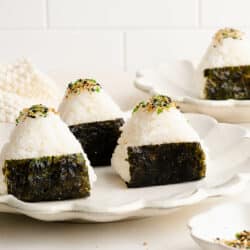Easy Onigiri

- Prep Time: 20 mins
- Cook Time: 40 mins
- Total Time: 1 hour
- Yield: Makes about 6 onigiri
- Category: Lunch
- Method: Stove Top
- Cuisine: Japanese
Tuna Onigiri are a tasty and nutritious snack made with sushi rice, filled with a delicious tuna mayo filling, and wrapped in crispy seaweed. Make these delightful rice balls at home for the perfect snack or light meal.
Ingredients
For the Sushi Rice
- 350 g (heaped 1 1/2 cup) sushi rice
- 500 ml (2 cups) cold water
For the Seasoning
- 2 1/2 tablespoons rice vinegar
- 1 1/2 teaspoon sugar
- 1/2 teaspoon fine salt
For the Filling
- canned tuna, drained
- 2–3 tablespoons Japanese Kewpie mayonnaise
- 1 tablespoon lemon juice, or to taste
- freshly ground white pepper, to taste
- handful chives, finely chopped
To Serve
- nori (seaweed) sheets OR nori seaweed snack
- furikake
- shiso or perilla leaves, optional
Instructions
To Make the Sushi Rice
- Measure the rice into a bowl.
- Transfer the rice into a fine sieve through which the rice grains cannot escape.
- Wash and rinse the rice under a cold tap until the water runs clear. Use your hands to gently move the rice around the sieve. At first, the water will appear milky and cloudy, but as the starch rinses away, the water will start to look clear.
- Shake the sieve to remove as much excess water as possible.
- Transfer the rinsed rice to a medium-sized saucepan with a tight-fitting lid. I like to use a cast-iron pot to cook my rice, but any stainless steel pan will work as well.
- Measure the water.
- Pour the water over the rice in the saucepan.
- Cover the saucepan with a lid.
- Place the saucepan on the stove.
- Cook the rice on low to medium heat for 30 minutes. The water should not come to a boil; it should just gently simmer so that the rice will cook slowly and gently. A glass lid will help you to see how the rice is cooking.
- After 30 minutes, turn off the stove and remove the saucepan from the heat source.
- Let the rice continue to steam for about 10 minutes, but you can skip this step if you are in a hurry.
- Fluff the rice before serving.
To Season the Sushi Rice
- Transfer the rice to a large sheet pan or similar.
- Using a rice paddle, spread out the rice in a thin layer so that it can cool down quickly.
- Sprinkle over the seasoning ingredients.
- Use the rice paddle to mix everything together by folding the rice over onto itself, and then spreading it out again.
- Leave the rice to cool until it is at room temperature before using in recipes for sushi, onigiri or similar.
To Make the Tuna Filling
- Drain the tuna.
- Place the tuna into a medium-sized mixing bowl.
- Flake the tuna with a fork.
- Add the remaining ingredients.
- Mix everything together until the ingredients are well combined.
- Taste for seasoning.
- I like to transfer the filling to a large piping bag, but you can skip this step.
To Assemble the Onigiri
- Use a small spoon or spatula to place some rice into the onigiri mould, about halfway up.
- Use the spoon to compact the rice together gently.
- Use a melon-baller or similar to make a small dent in the middle of the rice.
- Place about a teaspoon of the tuna filling into this dent.
- Cover the tuna filling with more rice, enough to fill the mould.
- Place the lid onto the onigiri mould and press gently to compact everything together.
- Gently remove the onigiri from the mould.
- Wrap the bottom of the onigiri with a piece of nori, cut as big or as small as you like. Alternatively, use a shiso leaf or perilla leaf in place of the nori.
- Sprinkle the top of the onigiri with some furikake.
- Serve the onigiri immediately.
- Onigiri is best made just before serving, but it can keep for a few hours in the fridge. If you are not serving the onigiri right away, wrap them individually in plastic wrap to prevent the rice from drying out.
Kitchen Notes
 WHAT TEMPERATURE TO COOK RICE
WHAT TEMPERATURE TO COOK RICE
Each stove is different, so you will have to experiment with your stove a bit. But generally speaking, you want a low to medium heat so that the water comes to a gentle simmer. The rice will cook slowly and gently. For my Bora induction stove, I use setting 5 out of 9.
 RATIO OF RICE TO WATER
RATIO OF RICE TO WATER
For sushi rice, you generally need a ratio of 1:1.25 of rice to water. My recipe uses a ratio of approximately 1:1.4. I think the ratio can vary slightly according to personal preference, as well as the rice you are using. Sometimes when I change brands of rice, I find that my usual recipe yields cooked rice which is too moist or too dry. I recommend experimenting by increasing or decreasing the amount of water by 1 tablespoon at a time.
 MAKE IT SPICY
MAKE IT SPICY
Add some sriracha to the tuna filling for a spicy kick.
 CONVERSIONS
CONVERSIONS
To convert from cups to grams, and vice-versa, please see this handy Conversion Chart for Basic Ingredients.
 OVEN & STOVE TEMPERATURES
OVEN & STOVE TEMPERATURES
All recipes on this website have been tested on an induction stove and/or with a conventional oven (i.e. an oven without fan). All recipes on this website use temperatures for a conventional oven, unless otherwise mentioned. Convection ovens (i.e. fan-forced ovens) are typically 20°C/70°F hotter than conventional ovens, but please check your manufacturer’s handbook.
View the recipe online: https://eatlittlebird.com/onigiri-recipe/
